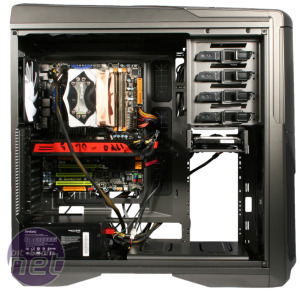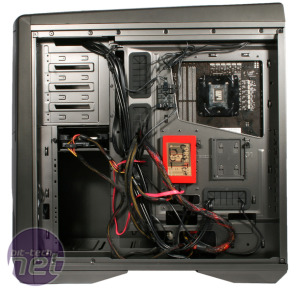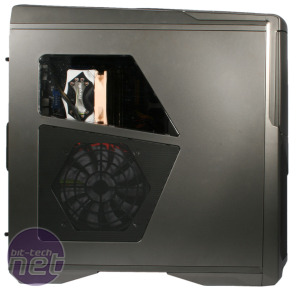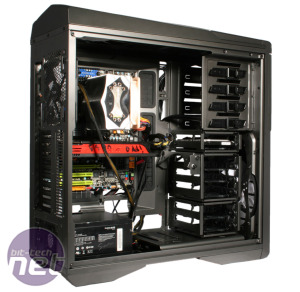
Performance Analysis
The Phantom 630 is a very quiet beast with its fans on low speed, just as the Phantom 820 is. At this setting, it produced a CPU delta T of 52°C, which is unsurprisingly exactly the same as the Phantom 820 on its lowest speed. It's also on par with Lian Li's massive PC-A76, which costs roughly the same but lacks the capacity to increase its fan speed. Meanwhile, our graphics card gave a delta T result of 51°C, also the same as Lian Li's case, and also in line with other large or low noise cases.Flicking the fan controller's switch to its medium setting results in a noticeable but still only subtle increase in noise output. The increased airflow from the pair of exhaust fans results in a 2°C drop in the CPU delta T. Its result of 50°C here is enough to bring it in line with the huge Xigmatek Elysium. Our GPU at this speed setting also sheds 2°C from its delta T, dropping it to 49°C, the same as the Phantom 820 on full speed.
At high speed, the increase in noise output is more noticeable than the jump from low to medium. However, the Phantom 630 is able to drop another 2°C from its CPU delta T result at this speed, with the new result of 48°C again matching the Phantom 820 on full speed, and being a very good result generally. Cases that post delta T results lower than this tend to be either smaller, where airflow is more concentrated, or simply louder. Disappointingly, however, the GPU delta T remained at 49°C at full speed, so the medium setting is the better compromise between noise and performance.
We also tested the Phantom 630 at each of its speed settings with five out of six of the drive bays removed, freeing up space for the front intake fan's airflow. However, at low and medium settings, delta T results remained exactly the same, hence their exclusion from the performance charts. Only at high speed was there a difference, and it was a small one. The GPU delta T went down by 1°C to 48°C, putting it just ahead of the Phantom 820's best result, but still fairly low down. This suggests that the front intake is positioned too far away from the GPU area to make much difference, as is often the case in such a large chassis.
Conclusion
The Phantom 630 comes off favourably compared to its larger predecessor, mostly thanks to it costing at least £40 less at current prices. Air cooling performance is the same as before, if not slightly better (although we'll say again that GPU temperatures could be improved if the internal fan mount was filled by default), and very little is lost in the way of water-cooling support. The attractive HUE lighting system may be missing but it was always a luxury, and though the fan controller is no longer multi-channel, it's still a powerful addition and benefits from its new simplicity. There's even room for two more SSDs than before, so functionally the Phantom 630 is still among the best.A few design choices do leave a sour taste in our mouths, however. The cable management, while relatively excellent, lacks the finesse of the Phantom 820 which gave us one of the tidiest builds to date. The real insult, however, is the continued use of the shoddy drive trays from before. We can forgive NZXT for utilising the same aesthetic across its Phantom range, but these mounts have got to go. We almost resent ourselves for giving the Phantom 630 an Approved award, but in the end the case has many more pros than cons, and we can't deny that it emerges as a winner overall.

-
Cooling20 / 30
-
Features19 / 20
-
Design26 / 30
-
Value18 / 20


MSI MPG Velox 100R Chassis Review
October 14 2021 | 15:04












Want to comment? Please log in.